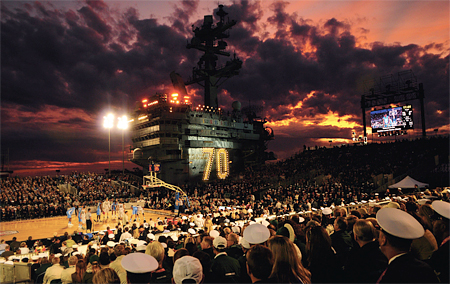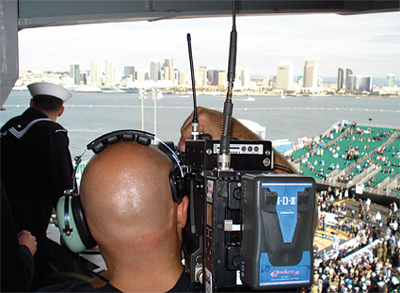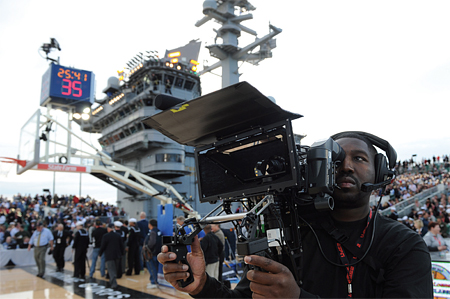Carrier Classic Scores High Ratings for ESPN
SAN DIEGO—To honor the nation's veterans on Veteran's Day 2011, ESPN presented the "2011 Quicken Loans Carrier Classic," a groundbreaking live show featuring a matchup between NCAA Division I Men's Basketball teams Michigan State University and University of North Carolina on the flight deck of the U.S. Navy aircraft carrier USS Carl Vinson.

The event, which kicked off at 4 p.m. PST/7 p.m. EDT, garnered ESPN a 2.7 rating, the highest it's received for a November college basketball game since 2001. Broadcast in both stereo 3DTV and HD, the Carrier Classic presented many creative, technical, and logistical challenges since it was the first production of its kind. President Barack Obama, accompanied by first lady Michelle Obama, kicked off the event with a patriotic message honoring the service of our troops.
"We were extremely pleased to be part of this historic event," said Dave Miller, senior coordinating producer for ESPN. "Our goal was to offer our viewers something very innovative and unique. The carrier proved to be a very exciting venue for this game."
LOGISTICAL HURDLES
The USS Carl Vinson, a Nimitz class, nuclear-powered aircraft carrier, was docked in San Diego Bay for the event. Preproduction, which began in March, consisted of many diagrams, drawings, meetings and conference calls with the event organizer, Morale Entertainment—as well as site surveys of the ship in June and August.
"Many logistical challenges stemmed from the fact that this high security aircraft carrier was an unconventional venue for college basketball," Miller said. "Production challenges included natural light ranging from bright sun to dusk then nightfall and concerns about wind, fog, and rain." Fortunately the weather cooperated throughout the game.

Broadcast Sports Inc. provided wireless camera technology for the Carrier Classic. Morale Entertainment, a non-profit organization that brings entertainment to U.S. military forces, supervised the construction of a temporary basketball court, four lighting towers, and stadium seating for 7,000 VIP guests on the flight deck. But since the five-day forecast called for rain, the company also began constructing a backup basketball court and stadium seating on the hanger deck below. When it became clear that the Friday night game would not be rained out, the contingency plan was halted. Brown United built the adjacent Sports Center set for ESPN. The entire event reportedly cost $2 million to produce.
Production plans remained fluid up until game time. "While we had a plan for camera positions, we didn't really know the exact camera vantage points until we were setting up, and that was a challenge," Miller said. "As it turned out, the cameras were lower and closer to the action which worked out better for 3D." There were 13 cameras, most of which were specially designed Pace stereo 3D cameras systems. Camera positions included five fixed, three robotic, and three handheld cameras.
WIRELESS RF
Broadcast Sports Inc. (BSI), in Hanover, Md., configured one of the handheld cameras, a Sony 1500 HD camera, for wireless RF transmission. "Wireless RF transmission enables the cameraman to walk freely in any direction and not worry about tripping anyone," said Lou Meyers, BSI's engineer in charge at the Carrier Classic. "BSI provided a very robust RF infrastructure including the transmitter for the camera and RF receivers. We did extensive testing prior to the event to determine where the RF signal was strongest and distributed the receivers strategically to cover the production."

ESPN covered the Carrier Classic in HD and 3D. BSI was also responsible for frequency coordination to enable the wireless RF transmissions. "Since President Obama was on-board, and it's a military installation, there were national security concerns that made frequency coordination especially challenging," said Clay Underwood, BSI's technology development manager. "We had to be agile enough to switch frequencies when necessary. And we also obtained temporary access to a band of spectrum reserved for aeronautical and military telemetry and testing. In addition to our wireless RF camera systems, BSI is the only vendor of RF broadcast mics capable of operating in this military band."
FOCUS ON 3D
BSI parked its truck—which was responsible for receiving the RF signals and quality control—alongside ESPN's "5D" truck in a lot about 300 feet from the ship. Besides the fiber run between the ESPN and BSI trucks, cables were also run all the way up to the upper flight deck and around the stadium seating—a relatively long cable run.
ESPN's need to produce stereo 3DTV alongside HDTV gave rise of the unique 5D workflow—where stereo 3D and 2D are produced on a single mobile unit, SS32, which was custom-built for ESPN by NEP Broadcasting. In the 5D workflow, 3D cameras feed both left and right eye signals into a massive 200x100 Sony MVS-8000x production switcher. Then the left-eye portion of the finished stereo 3D program is used to feed ESPN's 2D networks. SS32 also has consoles for stereography and image convergence, as well as a Vizrt realtime graphics workflow.
The ESPN production delegation included Producer Josh Hoffman, Director Doug Holmes, Operations Manager Terri Hermann, Technical Manager Jeff Willis, TD Seth Manway, and Operations Producer Jack Sheehan.
"The U.S. Navy was very supportive of our production needs," said Miller. "Hopefully we'll do it again."
The professional video industry's #1 source for news, trends and product and tech information. Sign up below.

